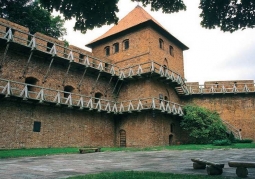Elbląg Canal
No weather data
0.0 /5
Number of ratings: 0
Elbląg Canal (German: Oberländischer Kanal, Polish Oberland Canal) - a navigable waterway in the Warmian-Masurian Voivodeship. The channel is also sometimes called the Elbląg-Ostróda Canal or the Ostróda-Elbląg Canal. In 1978, a fragment of the canal was declared a technical monument, while by the Regulation of the President of the Republic of Poland of January 14, 2011, it was declared a historical monument. In 2007, the Elbląg Canal was recognized as one of the seven wonders of Poland in the Rzeczpospolita plebiscite. Its length is 84.2 km: Druzno lake section - Miłomłyn lock, 52.0 km section Miłomłyn - Iława section, 32.2 km long The total length of the canal with branches is 151.7 km, although data specifying the length of the main waterway can be found at 127.5 km, and lateral branches - at 65 km. The channel connects Druzno Lake with Drwęca and Jeziorak Lake. From Lake Druzno, through the Elbląg River with the Vistula Lagoon, as well as through the Jagiellonian Canal, Nogat and Vistula with the Baltic Sea. Due to its natural and cultural values, the area has been protected by law in the form of the Protected Landscape Area of the Elbląg Canal. Description: Continent Europe Poland State Warmian-Masurian Voivodeship Beginning of Elbląg End of Ostróda Construction year 1844-1860 Length 84.2 km Level difference 99.5 m Navigable channel type Available for navigation Lock 4 Incline 5 Source: wikipedia
Komentarze
No results
Nearby places

Radziejowski Tower - Cathedral Complex - Frombork
Category: BelfriesThe belfry called the Radziejowski tower is a Gothic-Baroque building from the 16th-17th centuries. It burned down in 1945 and was rebuilt in 1972-1973. The basement houses the museum planetarium. Upper art exhibitions...
37 km

Copernicus Tower - Cathedral Complex - Frombork
Category: Defensive Fortifications and CastlesThe Copernicus Tower is the oldest element of the fortifications of the Cathedral Hill. It was built before 1400, the upper floors were rebuilt several times in the space of the 15th-18th centuries. In the years...
37 km

Archcathedral Basilica of the Assumption of the Blessed Virgin Mary and St. Andr - Cathedral Complex - Frombork
Category: BasilicaFortified, Gothic cathedral built in the years 1329-1388. Here is the grave of Nicolaus Copernicus. It was here that the great astronomer lived and worked and announced his work "De revolutionibus orbium coelestium" (On...
37 km

Nicolaus Copernicus Museum - Cathedral Complex - Frombork
Category: MuseumsThe museum was founded in 1912 by canon Eugen Brachvogel. The first exhibition hall was built on the Cathedral Hill in the so-called Copernicus Tower. Next to it is the belfry called the Radziejowski Tower planetarium...
37 km
Nearby places

Radziejowski Tower - Cathedral Complex - Frombork
Category: BelfriesThe belfry called the Radziejowski tower is a Gothic-Baroque building from the 16th-17th centuries. It burned down in 1945 and was rebuilt in 1972-1973. The basement houses the museum planetarium. Upper art exhibitions...
37 km

Copernicus Tower - Cathedral Complex - Frombork
Category: Defensive Fortifications and CastlesThe Copernicus Tower is the oldest element of the fortifications of the Cathedral Hill. It was built before 1400, the upper floors were rebuilt several times in the space of the 15th-18th centuries. In the years...
37 km

Archcathedral Basilica of the Assumption of the Blessed Virgin Mary and St. Andr - Cathedral Complex - Frombork
Category: BasilicaFortified, Gothic cathedral built in the years 1329-1388. Here is the grave of Nicolaus Copernicus. It was here that the great astronomer lived and worked and announced his work "De revolutionibus orbium coelestium" (On...
37 km

Nicolaus Copernicus Museum - Cathedral Complex - Frombork
Category: MuseumsThe museum was founded in 1912 by canon Eugen Brachvogel. The first exhibition hall was built on the Cathedral Hill in the so-called Copernicus Tower. Next to it is the belfry called the Radziejowski Tower planetarium...
37 km



